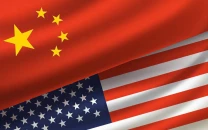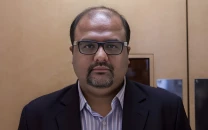Sikhs in Pakistan: Contentious calendars
Nankana Sahib becomes a hotbed of disagreement once again as the Sikh community discusses its future.

Sikhs in Pakistan: Contentious calendars
Prominent Sikh leaders like Sardar Ganga Singh Dhillon, who were proponents of Khalistan, a separate Sikh nation-state, used to make poignant speeches in favor of breaking away from the ‘Hindu’ and ‘Banya raj’ of India.
At the time, after his speech the leader would be warmly received by the audience, a response which would send shivers down the spines of the Indian officials who used to accompany pilgrims to Nankana Sahib for Guru Nanak’s birthday celebrations.
At the time banners in favor of separatism were strung all around the city. Various religious events in Pakistan, including Vaisakhi, Guru Arjun’s martyrdom, and the birthday of Maharaja Ranjit Singh were used as political platforms for the cause of Khalistan. However, the movement, which reached its zenith after the desecration of the Golden Temple in Amritsar by the Indian army in 1984, faded away by the 90s. After that, religious festivals went back to being religious festivals, with only a few exceptions here and there.
However, the night of March 13, 2011 was not a regular night. This was the last night of the year according to the Sikh Nanakshahi calendar. The community had gathered at the Gurdwara Janamasthan along with a few pilgrims from Sindh to mark the event. Kalyan Singh Kalyan, a young man from Nankana, was in-charge of the stage and he used that opportunity to speak against the influence of the Hindu lobby on the Indian government; reminiscent of the scene in the 80s.
However, there were some marked differences: Whereas those leaders from times past would be appreciated and applauded by the audience, Kalyan Singh’s audience hardly seemed concerned. There are at least two reasons for this: firstly, the nationalistic fervor that defined that movement in the 80s has been sidelined. Secondly, the previous crowd comprised mostly of Indian pilgrims, who are directly impacted by the Indian government’s politics. Kalyan Singh’s current audience was made up of a few hundred Pathan Sikhs and Sindhi Hindus. They were never associated with the movement, and neither are they very concerned now.
Kalyan Singh Kalyan, who is pursuing his doctorate in Punjabi literature and studying in Punjab University, however, takes a keen interest in politics. In the 2008 elections, he even tried to stand for the seat of MPA on the reserve seats for the Pakistan People’s Party (PPP), but lost to a Christian candidate. He says, “We (the Sikhs) are not part of Hinduism, but are a separate nation, with a separate constitution. Therefore the Hindus shouldn’t oppress us.”
Another recent point of contention in the community is the Nanakshahi calendar. First implemented in 2003 by the Shiromani Gurdwara Parbandhak Committee (SGPC), one of the most important Sikh bodies based in Amritsar, the calendar received a mixed response from the people. It was supported by a lot of expatriates but within India, there were a few Sikhs in important posts who weren’t sure about it. Puran Singh, the jathedar (priest) of Akal Takht (the throne of the God) in the Golden Temple, opposed it when it was implemented. The jathedar of the Akal Takht is the highest spiritual post in the Sikh fraternity. To show his resentment, he celebrated the birthday of Guru Gobind Singh according to the previous calendar, whereas the SGPC celebrated it according to the new one. Similarly, there was also a lot of confusion within the community, who didn’t know which calendar to follow.
Before the new calendar was implemented, the Sikh community followed the Bikrami calendar, which is the Hindu calendar. Based on a combination of lunar and solar calculations, it resulted in the dates of Sikh festivals being shifted every year. In addition, it was associated with the Hindu tradition and a lot of Sikhs felt, especially after the Khalistan movement, that there was a need to assert a separate identity. Keeping these problems in mind, Canadian Sikh Pal Singh Purewal created a solar calendar, which permanently pinned down the dates of the festivals. It took him about 16 years to devise it. In 1998 he placed it in front of the community for criticism. When nobody came forward to criticise it, it was implemented in 2003.
The Nanakshahi calendar, however, remained a thorn in the Indian government’s side. Haunted by the years of Khalistan, which eventually led to the assassination of Indian Prime Minister Indira Gandhi by her own Sikh body guards, the government remained skeptical of Sikhs exerting their autonomy. As soon as the calendar was implemented, the Chief Minister of Punjab Amarinder Singh stated that the government would not implement the Nanakshahi calendar and that state and religious holidays would still be celebrated according to the previous one. It is also interesting to note that Amarinder Singh once supported the Khalistan movement.
Ever since independence, and especially since the Khalistan days, the Indian government has tried to control both the SGPC and the priests at the Takhts. Whereas it has been difficult to exert much influence over the former, because of the election of its main body, influencing the latter has been much easier, which is cited as one of the reasons as to why the jathedar of Akal Takht disapproved of the calendar. Following his lead, the jathedar of Takht Patna Sahib also distanced himself from it. The Sikhs have a total of five Takhts, which are the spiritual authorities of the community. The most important one is the Akal Takht, established at the Golden Temple, by the tenth Sikh Guru Gobind Singh. Kalyan Singh feels that the Hindu lobby exerts ‘extra’ influence over the Takht Patna Sahib.
The calendar functioned, in the form that Purewal made it, for seven years. In 2010, under what experts feel was the influence of the Indian government, the SGPC approved amendments in the calendar, which brought it closer to the Bikrami calendar. This diluted the distinction that the calendar had. Purewal, and a lot of other international Sikh leaders spoke out against the changes. Now Purewal feels that even though the calendar retains its name, it doesn’t include any of the features that rendered it unique.
The New Year festival that was arranged by the local Sikh community of Pakistan was also organised in response to the changes made in the Nanakshahi calendar. Another speaker on the occasion was Sham Singh, the President of the Pakistan Gurdwara Prabandhak Committee (PGPC). He also termed the changes to be the ‘connivance’ of the Hindu lobby. PGPC, which maintains close ties with the international Sikh community, and leaders like Ganga Singh disapproved the changes in the Nanakshahi calendar; therefore, it supported Kalyan Singh when he decided to raise his voice against what he felt to be Indian tyranny. Thus, once again, Nankana Sahib became the hotbed of Indian and Pakistani ‘Sikh’ politics, providing a fertile ground for the agencies of both the countries to operate.
Published in The Express Tribune, Sunday Magazine, May 8th, 2011.



















COMMENTS
Comments are moderated and generally will be posted if they are on-topic and not abusive.
For more information, please see our Comments FAQ